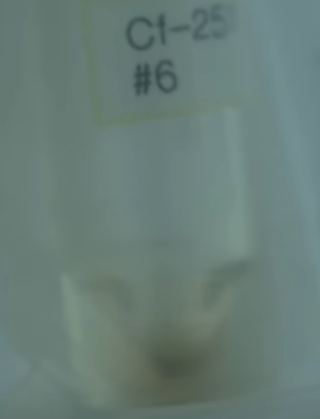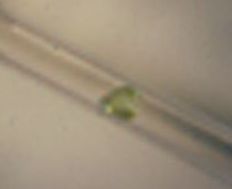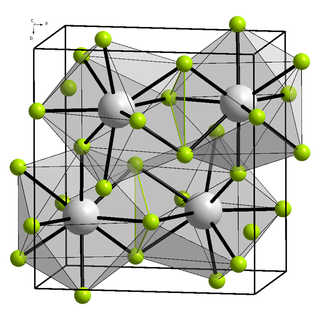
Berkelium is a synthetic chemical element; it has symbol Bk and atomic number 97. It is a member of the actinide and transuranium element series. It is named after the city of Berkeley, California, the location of the Lawrence Berkeley National Laboratory where it was discovered in December 1949. Berkelium was the fifth transuranium element discovered after neptunium, plutonium, curium and americium.

Curium is a synthetic chemical element; it has symbol Cm and atomic number 96. This transuranic actinide element was named after eminent scientists Marie and Pierre Curie, both known for their research on radioactivity. Curium was first intentionally made by the team of Glenn T. Seaborg, Ralph A. James, and Albert Ghiorso in 1944, using the cyclotron at Berkeley. They bombarded the newly discovered element plutonium with alpha particles. This was then sent to the Metallurgical Laboratory at University of Chicago where a tiny sample of curium was eventually separated and identified. The discovery was kept secret until after the end of World War II. The news was released to the public in November 1947. Most curium is produced by bombarding uranium or plutonium with neutrons in nuclear reactors – one tonne of spent nuclear fuel contains ~20 grams of curium.

Californium is a synthetic chemical element; it has symbol Cf and atomic number 98. The element was first synthesized in 1950 at Lawrence Berkeley National Laboratory, by bombarding curium with alpha particles. It is an actinide element, the sixth transuranium element to be synthesized, and has the second-highest atomic mass of all elements that have been produced in amounts large enough to see with the naked eye. The element was named after the university and the U.S. state of California.

Einsteinium is a synthetic chemical element; it has symbol Es and atomic number 99. Einsteinium is a member of the actinide series and it is the seventh transuranium element. It was named in honor of Albert Einstein.

Few compounds of californium have been made and studied. The only californium ion that is stable in aqueous solutions is the californium(III) cation. The other two oxidation states are IV (strong oxidizing agents) and II (strong reducing agents). The element forms a water-soluble chloride, nitrate, perchlorate, and sulfate and is precipitated as a fluoride, oxalate or hydroxide. If problems of availability of the element could be overcome, then CfBr2 and CfI2 would likely be stable.

Berkelium forms a number of chemical compounds, where it normally exists in an oxidation state of +3 or +4, and behaves similarly to its lanthanide analogue, terbium. Like all actinides, berkelium easily dissolves in various aqueous inorganic acids, liberating gaseous hydrogen and converting into the trivalent oxidation state. This trivalent state is the most stable, especially in aqueous solutions, but tetravalent berkelium compounds are also known. The existence of divalent berkelium salts is uncertain and has only been reported in mixed lanthanum chloride-strontium chloride melts. Aqueous solutions of Bk3+ ions are green in most acids. The color of the Bk4+ ions is yellow in hydrochloric acid and orange-yellow in sulfuric acid. Berkelium does not react rapidly with oxygen at room temperature, possibly due to the formation of a protective oxide surface layer; however, it reacts with molten metals, hydrogen, halogens, chalcogens and pnictogens to form various binary compounds. Berkelium can also form several organometallic compounds.
Californium polyborate is a covalent compound with formula Cf[B6O8(OH)5]. In this compound the californium is in a +3 oxidation state.

Actinocenes are a family of organoactinide compounds consisting of metallocenes containing elements from the actinide series. They typically have a sandwich structure with two dianionic cyclooctatetraenyl ligands (COT2-, which is C
8H2−
8) bound to an actinide-metal center (An) in the oxidation state IV, resulting in the general formula An(C8H8)2.
The telluride phosphides are a class of mixed anion compounds containing both telluride and phosphide ions. The phosphidotelluride or telluridophosphide compounds have a [TeP]3− group in which the tellurium atom has a bond to the phosphorus atom. A formal charge of −2 is on the phosphorus and −1 on the tellurium. There is no binary compound of tellurium and phosphorus. Not many telluride phosphides are known, but they have been discovered for noble metals, actinides, and group 4 elements.

Thomas Albrecht-Schönzart is an American radiochemist specializing in the chemistry and physics of transuranium elements. He is jointly appointed as a University Distinguished Professor at the Colorado School of Mines in Golden, Colorado, and Director of the Nuclear Science & Engineering Center and Idaho National Laboratory.
The borate iodides are mixed anion compounds that contain both borate and iodide anions. They are in the borate halide family of compounds which also includes borate fluorides, borate chlorides, and borate bromides.

Californium(III) bromide is an inorganic compound, a salt with a chemical formula CfBr3. Like in californium oxide (Cf2O3) and other californium halides, including californium(III) fluoride (CfF3), californium(III) chloride, and californium(III) iodide (CfI3), the californium atom has an oxidation state of +3.
Curium(III) nitrate is an inorganic compound, a salt of curium and nitric acid with the chemical formula Cm(NO3)3.
A phosphate phosphite is a chemical compound or salt that contains phosphate and phosphite anions (PO33- and PO43-). These are mixed anion compounds or mixed valence compounds. Some have third anions.
Einsteinium compounds are compounds that contain the element einsteinium (Es). These compounds largely have einsteinium in the +3 oxidation state, or in some cases in the +2 and +4 oxidation states. Although einsteinium is relatively stable, with half-lives ranging from 20 days upwards, these compounds have not been studied in great detail.

Berkelium(III) chloride also known as berkelium trichloride, is a chemical compound with the formula BkCl3. It is a water-soluble green salt with a melting point of 603 °C. This compound forms the hexahydrate, BkCl3·6H2O.

Californium(III) fluoride is a binary inorganic compound of californium and fluorine with the formula CfF
3
Californium(III) oxide is a binary inorganic compound of californium and oxygen with the formula Cf
2O
3. It is one of the first obtained solid compounds of californium, synthesized in 1958.
Californium(IV) oxide is a binary inorganic compound of californium and oxygen with the formula CfO
2.
Californium(II) iodide is a binary inorganic compound of californium and iodine with the formula CfI
2.











